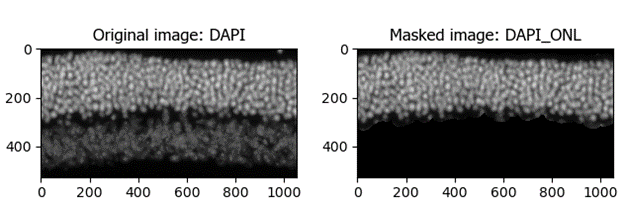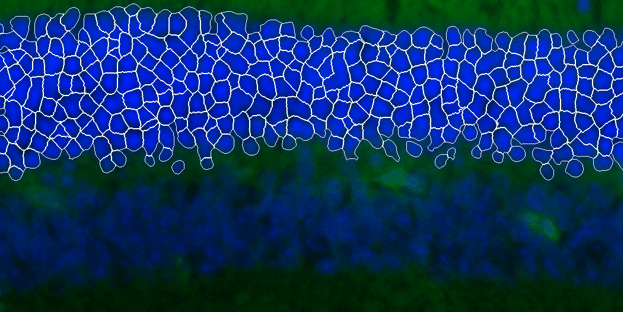Visikol utilizes fluorescent retinal images for quantifying disease states associated with the eye and the effects of drugs in relation to associated disease states. Within the retina is the outer nuclear layer (ONL), the ONL contains photoreceptor cells made up of rod and cone cell bodies which is a popular region of interest for experimental observations and clinical implications. This makes it imperative to isolate the ONL via segmentation for further analysis. In the example we’ll discuss below; the ONL is successfully isolated through intensity thresholds and morphological functions applied on the DAPI channel of fluorescent retinal cryosection images in CellProfiler.
The first step was to identify and segment DAPI+ objects in the entire eyecup. Once the DAPI+ objects are segmented, intensity measurements are recorded and employed to filter DAPI objects into two groups: outer nuclear layer and inner nuclear layer (INL). The threshold value that separates the ONL and INL is dependent on microscope settings and lighting conditions. The difference in intensity between the ONL and INL, with ONL appearing brighter, is due to the density of cells present in the ONL as compared to the INL. With more cells and DAPI+ signal, means greater intensity in that region. In this case, a minimum value of 0.25 (in range of 0-1; the value is calculated by dividing all pixels in the image by the maximum possible intensity value) mean intensity was set to filter all objects brighter than 0.26 and label them as ONL.

The newly identified ONL objects were then dilated in efforts to encompass the entire ONL region. This step is taken because the intensity threshold removes some ONL cells that have a lower intensity than the threshold value.
Then a maximum value of 0.22 mean intensity was utilized to filter out objects that are dimmer than 0.22 and label them as INL. This method could also be applied to isolate the INL, given that it is the focus of the study.

Measurements of INL object size and shape were taken and they were filtered to exclude any objects that have a maximum mean radius greater than 5. This step was to ensure that ONL objects are removed from the INL mask; it’s an extra measure at isolating the ONL, since each image can have varied pixel intensity. If you’re seeking INL isolation, you could dilate the filtered objects as it was done on the ONL objects instead.
From there, the original DAPI channel image was taken and the ONL objects were masked over it to isolate all DAPI+ cells that are in the ONL. The masked image was then taken and inversely masked with INL objects so that what is left is most likely part of the ONL.

A combination of filtering by intensity and morphology allowed for isolation of the ONL from the whole retinal cryosection while maintaining autonomous detection by CellProfiler. Visikol’s image analysis team excels in balancing solving problems with maximal accuracy and keeping the methodology efficiently simple, contact us for all your biological study needs!

Retinal cryosection where ONL layer (outlined in white) is successfully isolated from the rest of the eyecup using intensity and morphological filters. A mask is created of the ONL objects which is then applied to the original image.
